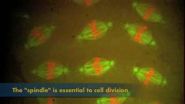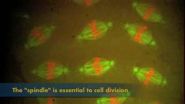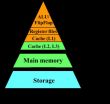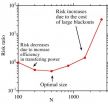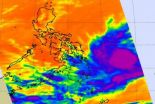(Press-News.org) VIDEO:
Kinesin-5 plays a crucial role in cell division by allow microfilaments to slide past each other. The kinesin-5 structure shows a central rod connecting two motor units that walk along...
Click here for more information.
The structure of a key part of the machinery that allows cells to divide has been identified by researchers at the University of California, Davis -- opening new possibilities for throwing a wrench in the machine and blocking runaway cell division in cancer.
"The structure of kinesin-5 is unexpected, and the implications are big -- it allows us to target it, for example in various forms of cancer," said Jawdat Al-Bassam, assistant professor of molecular and cellular biology at UC Davis, who led the project.
"This fills in a major missing piece, because for the first time we can understand how microtubule filaments can be linked together and slide past each other," he said.
The work will be published in the online journal eLife and is available at (elife website DOI)When a cell divides into two new cells, a structure called the mitotic spindle forms. Microtubules of protein fan out from each end of the cell, capture chromosomes and draw them apart into what will become the two new cells. Precise coordination of this process is crucial for cells to divide properly, and for avoiding birth and developmental defects.
Cancer cells divide continuously, so this process repeats itself much more often in cancer cells than in normal cells.
The kinesins are a large family of motor proteins that move items around inside cells, said Jonathan Scholey, professor of molecular and cellular biology at UC Davis and an author on the paper. Generally, they have two motor units at one end that can "walk" along a microtubule, dragging cargo attached to the other end of the protein.
Originally identified as a protein essential for mitosis in fungi, kinesin-5 was first purified about 20 years ago by Scholey's lab who found that it is unusual because it has motor units at both ends, allowing it to link two microtubules and walk them past each other.
"It's now understood to be absolutely essential for mitosis in virtually all eukaryotic cells," Scholey said.
Using electron microscopy and X-ray crystallography, Al-Bassam, Scholey, Project Scientist Stanley Nithianantham and research specialist Jessica Scholey determined the atomic structure of the central rod of kinesin-5. They found that it is made up of four long helices of protein bundled together, two running in each direction.
"This is a much more intertwined structure than we thought it would be," Scholey said.
The structure also revealed "pockets" unique to kinesin-5 that could be exploited as targets for new anti-cancer drugs. Kinesin-5 has been identified as a target for drugs to treat cancers that involve uncontrolled cell division, such as colorectal cancer, Al-Bassam said. One such drug recently advanced as far as phase III clinical trials but ultimately was not approved for general use because of its effect on other motor proteins. Drugs that could target kinesin-5 more precisely by binding the newly identified pockets would be a big advance, he said.
The structure also explains how forces can be transmitted through the central rod between the end motor units, Al-Bassam said.
"Previously we had only a cartoon-level model of how this so-called 'sliding filament' mechanism works, but the new work takes it to the next level and opens up the possibility of learning how it really works at an atomic scale, which is exciting," Scholey said.
INFORMATION:
Al-Bassam and Scholey are both scientific members of the UC Davis Comprehensive Cancer Center. The work was funded by the National Institutes of Health, including a "stimulus" award under the American Recovery and Reinvestment Act, and by the UC Cancer Coordinating Committee.
Full text of the paper is available at: http://elife.elifesciences.org/content/3/e02217
Kinesin-5 structure opens cancer drug targets
2014-04-08
ELSE PRESS RELEASES FROM THIS DATE:
Phase II trial of efatutazone shows challenge of matching treatment to population
2014-04-08
Work at the University of Colorado Cancer Center led to phase II trial of efatutazone with erlotinib in patients with refractory non-small cell lung cancer. Results are reported today at the American Association for Cancer Research (AACR) Annual Meeting 2014. While efatutazone did not improve the efficacy of erlotinib in this trial, researchers hope lessons from the trial will allow them to make better future use of the drug or other drugs in its class.
"In oncology and especially in lung cancer, everything is personalized. We're exploring different molecular markers ...
Glucosamine promotes longevity by mimicking a low-carb diet
2014-04-08
Glucosamine has been freely available in drugstores for many decades. It is widely used to treat arthritis and to prevent joint degeneration. Moreover, glucosamine is known to delay cancer growth. In addition, glucosamine reduces metabolism of nutritive sugars, as was already shown some 50 years ago.
In 2007, Michael Ristow showed that too much nutritive sugar shortens the lifespan of roundworms, a widely studied model organism in ageing research. Conversely, impairing carbohydrate metabolism in these worms was capable of extending lifespan [reference 1]. Unfortunately, ...
Future computers that are 'normally off'
2014-04-08
WASHINGTON D.C., April 8, 2014 -- If a research team in Japan gets its wish, "normally off" computers may one day soon be replacing present computers in a move that would both eliminate volatile memory, which requires power to maintain stored data, and reduce the gigantic energy losses associated with it.
Most parts of present computers are made with volatile devices such as transistors and dynamic random access memory (DRAM), which loses information when powered off. So computers are designed on the premise that power is "normally on."
Back in 2000, the concept of ...
Is the power grid too big?
2014-04-08
WASHINGTON D.C., April 8, 2014 -- Some 90 years ago, British polymath J.B.S. Haldane proposed that for every animal there is an optimal size -- one which allows it to make best use of its environment and the physical laws that govern its activities, whether hiding, hunting, hoofing or hibernating. Today, three researchers are asking whether there is a "right" size for another type of huge beast: the U.S. power grid.
David Newman, a physicist at the University of Alaska, believes that smaller grids would reduce the likelihood of severe outages, such as the 2003 Northeast ...
Rice U. study: Creativity and innovation need to talk more
2014-04-08
HOUSTON – (April 8, 2014) – Creativity and innovation are not sufficiently integrated in either the business world or academic research, according to a new study by Rice University, the University of Edinburgh and Brunel University.
The findings are the result of the authors' review of the rapidly growing body of research into creativity and innovation in the workplace, with particular attention to the period from 2002 to 2013.
"There are many of us who study employee creativity and many of us who study innovation and idea implementation, but we don't talk to each ...
The surprising truth about obsessive-compulsive thinking
2014-04-08
Montreal, April 8, 2014 — People who check whether their hands are clean or imagine their house might be on fire are not alone. New research from Concordia University and 15 other universities worldwide shows that 94 per cent of people experience unwanted, intrusive thoughts, images and/or impulses.
The international study, which was co-authored by Concordia psychology professor Adam Radomsky and published in the Journal of Obsessive-Compulsive and Related Disorders, examined people on six continents.
Radomsky and his colleagues found that the thoughts, images and ...
Where credit is due: How acknowledging expertise can help conservation efforts
2014-04-08
Scientists know that tapping into local expertise is key to conservation efforts aimed at protecting biodiversity – but researchers rarely give credit to these local experts. Now some scientists are saying that's a problem, both for the local experts and for the science itself.
To address the problem, a group of scientists is calling for conservation researchers to do a better job of publicly acknowledging the role of local experts and other non-scientists in conservation biology.
"For example, in the rainforests of the Yucatán, scientists couldn't even begin to do ...
Blocking DNA repair mechanisms could improve radiation therapy for deadly brain cancer
2014-04-08
DALLAS – April 8, 2014 – UT Southwestern Medical Center researchers have demonstrated in both cancer cell lines and in mice that blocking critical DNA repair mechanisms could improve the effectiveness of radiation therapy for highly fatal brain tumors called glioblastomas.
Radiation therapy causes double-strand breaks in DNA that must be repaired for tumors to keep growing. Scientists have long theorized that if they could find a way to block repairs from being made, they could prevent tumors from growing or at least slow down the growth, thereby extending patients' survival. ...
What songbirds tell us about how we learn
2014-04-08
This news release is available in French. When you throw a wild pitch or sing a flat note, it could be that your basal ganglia made you do it. This area in the middle of the brain is involved in motor control and learning. And one reason for that errant toss or off-key note may be that your brain prompted you to vary your behavior to help you learn, from trial-and-error, to perform better.
But how does the brain do this, how does it cause you to vary your behavior?
Along with researchers from the University of California, San Francisco, Indian Institute of Science ...
NASA satellite sees Tropical Depression Peipah approaching Philippines
2014-04-08
As Tropical Depression Peipah continues moving toward the central Philippines, NASA's Aqua satellite passed overhead and took an infrared look at the cloud top temperatures for clues about its strength.
On April 8 at 05:11 UTC/1:11 a.m. EDT/11 p.m. Manila local time, the Atmospheric Infrared Sounder instrument known as AIRS gathered infrared data on Tropical Depression Peipah. AIRS is one of the instruments that flies aboard NASA's Aqua satellite. The AIRS data showed thunderstorms with very cold cloud-top temperatures surrounded the center of the low-level circulation ...
